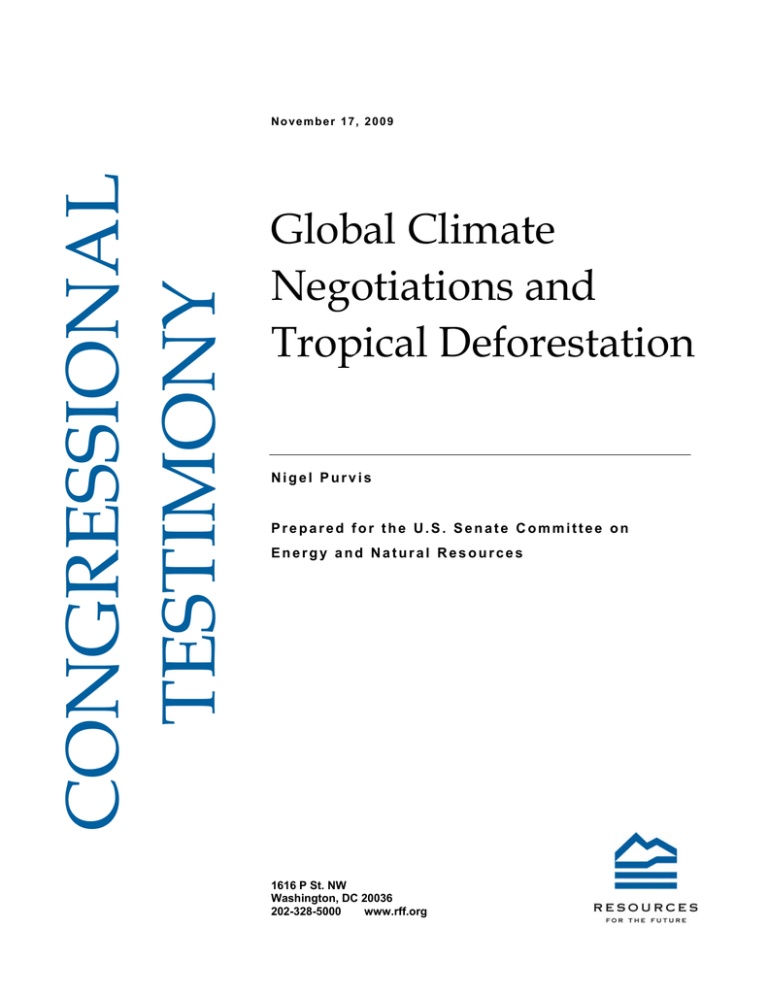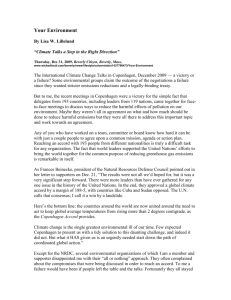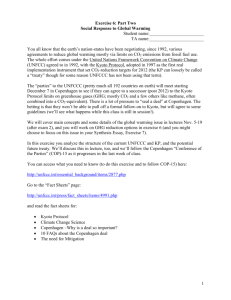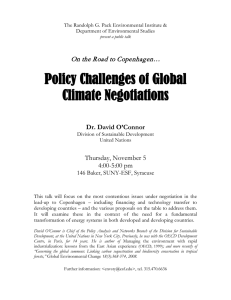Global Climate Negotiations and Tropical Deforestation
advertisement

CONGRESSIONAL TESTIMONY N o ve m b e r 1 7 , 2 0 0 9 Global Climate Negotiations and Tropical Deforestation Nigel Purvis Prepared for the U.S. Senate Committee on Energy and Natural Resources 1616 P St. NW Washington, DC 20036 202-328-5000 www.rff.org Global Climate Negotiations and Tropical Deforestation Written Testimony of Nigel Purvis President, Climate Advisers Prepared for the United States Senate Committee on Energy and Natural Resources November 17, 2009 Mr. Chairman, Senator Murkowski, and other distinguished members of the Committee, thank you for the opportunity to testify on international climate change policy. My name is Nigel Purvis, and I am president of Climate Advisers, a consulting firm that specializes in U.S. and international climate policy. From 1998 to 2002, I was a U.S. climate change negotiator, serving most recently as deputy assistant secretary of state for oceans, environment and science. Currently, I am also a scholar at Resources for the Future, the German Marshall Fund of the United States, and The Brookings Institution. These organizations neither lobby nor take positions on specific proposals. The views I present today are my own. Mr. Chairman, in requesting my participation at this hearing, you asked me to address two specific issues and their implications for U.S. climate policy. The first is the state of play of global climate negotiations. The second is the status of international efforts to reduce emissions from tropical deforestation. Copenhagen Let me begin with global climate talks. Two years ago, the international community set the goal of concluding next month in Copenhagen, Denmark, new global arrangements that would define the terms for international climate cooperation after 2012, when the Kyoto Protocol expires. Negotiations have proceeded under the United Nations Framework Convention on Climate Change, the leading global climate agreement to which almost all nations, including the United States, are parties. Status of Global Climate Negotiations With the Copenhagen conference just weeks away, most governments and experts now believe that it will prove impossible to finalize a new legal instrument this year. There are several reasons why. First, nations remain divided on important and contentious issues, including: • • The legal form of a new agreement—whether it should be legally binding and, if so, on what categories of countries. The emissions mitigation responsibilities of developed and developing nations. 1 • • The financial responsibilities of developed nations to assist developing nations adapt to climate change and pursue low-carbon economic growth. The mechanisms and institutional arrangements needed to verify emissions reductions and manage any new financial resources intended to assist developing nations. Resolving these issues would be difficult and time consuming under the best of circumstances. Climate agreements are every bit as complex as trade agreements and, like trade negotiations, climate negotiations sometimes defy political deadlines. The Kyoto negotiations took a decade from start to finish. The Copenhagen process will not require that long, but it will take some months or possibly years more. Second, the negotiations have been affected by significant uncertainty surrounding the shape of future U.S. climate and energy policies. The world learned from the Kyoto negotiations that the United States cannot deliver on new climate commitments unless the president and Congress see eye-to-eye. In 2008, the international community waited for a new American president. In 2009, nations have been waiting for the Obama administration and Congress to find common ground on climate and energy legislation. The United States is the world’s largest economy and, historically speaking, the world’s largest greenhouse gas emitter. In 1992 our nation pledged to return emissions to 1990 levels by 2000, and yet our emissions are far above that level today. Because we have the most innovative economy in the world, other nations reason that if we cannot reduce our emissions, perhaps few can. Understandably, other nations are reluctant to commit to ambitious climate policies until they see the United States reduce its emissions. Copenhagen Political Agreement Despite these significant challenges, there are many hopeful signs internationally. Several key nations— both developed and developing—are taking robust climate action at home. Increasingly, the world’s major economies believe that sound climate policies advance other important national interests, including energy security, economic growth, and public health. Internationally, countries are finding common ground on principles that could guide global cooperation. The Copenhagen conference presents an opportunity for nations to agree upon the architecture underpinning a new climate agreement even if reaching a full agreement is not yet possible. Progress made in Copenhagen on the structure for the next phase of global climate cooperation would initially be captured by nations in the form of a written political agreement rather than a legal instrument. Although political agreements do not create legally binding obligations under international law, by definition, a high-profile outcome from Copenhagen would be politically binding in the sense that nations would commit publicly to specific outcomes. A solid political agreement would send a clear signal about where the international community is heading while also providing concrete guidance to negotiators as they continue the work of crafting a complete international agreement. Architecture for a Copenhagen Agreement What could be included in such a political agreement coming out of Copenhagen? Here are a few specific examples where progress may be possible next month. 2 Shared Long-Term Goals—Nations could agree in Copenhagen to limit global warming to 2 degrees Celsius (3.6 degrees Fahrenheit) above pre-industrial levels and to reduce global emissions 50 percent by 2050. Developed countries could commit to reducing their emissions 80 percent, with developing nations committing that their emissions should decline significantly compared to business as usual by 2020 and peak by a certain date. Some of these goals were embraced earlier this year by key regional and economic groups, such as the G8, Major Economies Forum, and Asia Pacific Economic Cooperation (APEC), but Copenhagen presents an opportunity to elevate these long-term goals to the global level. Low-Carbon Growth Plans—Consensus has been building for each country to create a lowcarbon growth plan that describes in detail its long-term strategies for climate-friendly economic growth. The experience of countries that have created such plans shows that, done well, the process strengthens domestic political consensus for action and increases international transparency. International Registration of Domestic Actions—There is also growing agreement that global action on climate needs to be built on a foundation of domestic action, backed by domestic law, and that these domestic actions should be registered with the international community. Such registration of domestic programs would provide recognition for what each country is doing, help build trust, facilitate discussions of comparability, and enable a global assessment of the overall environmental adequacy of actions. Whereas low-carbon growth plans would show what nations plan to do, an international registry would record what nations are actually doing. Developed countries would commit to actions that achieved substantial reductions in national emissions from a base year. Developing nations would commit to nationally appropriate mitigation actions that would result in significant deviations from projected emissions trajectories. These actions would be supported by technical and financial assistance from developed nations. Measurement, Reporting, and Verification—Any agreement will require robust measurement, reporting, and verification to ensure commitments are met. Nations in Copenhagen can lay out the general framework for such a system by establishing the principle that all major emitters need to strengthen their international reporting and also participate in a credible verification system. Targets for 2020 Importantly, reaching agreement in Copenhagen on the architecture of the next global climate agreement may not be possible without some progress on targets and timetables for action. Developing nations are looking for clearer evidence that developed nations really will lead, as they agreed to do when adopting the U.N. Framework Convention on Climate Change. More specifically, developing nations are asking developed nations to commit in Copenhagen to firm emissions reduction targets for the year 2020. They are also asking developed nations to be specific about how much financing they will provide to the developing world to help nations adapt to climate change and pursue low-carbon economic growth. Most developed nations are ready to commit to 2020 mitigation and financing targets in Copenhagen. The European Union and Japan have already announced their emissions mitigation targets for 2020— 30 percent1 and 25 percent below 1990 levels, respectively. European leaders recently proposed a global 1 The European Union has pledged to reduce emissions 30 percent below 1990 levels by 2020 if other nations take comparable action, or 20 percent below 1990 levels by 2020 if other nations do not take comparable actions. 3 funding package of $150 billion annually by 2020 for climate change mitigation and adaptation in developing nations, with $33 billion to $75 billion in public funding per year from developed nations, and a fast-start fund of $7.5 billion to $10.5 billion total from 2010 through 2012. The Obama administration, therefore, faces a significant challenge. It needs to be forthcoming enough on U.S. mitigation and financing targets to keep international negotiations moving forward and avoid attempts to blame the United States, while at the same time not getting too far ahead of the Senate, which needs more time to consider climate and energy legislation. Major Step Forward from Kyoto Assuming the administration is able to strike the right balance, a political agreement in Copenhagen along the lines presented previously would be a major step forward from Kyoto. • • • • • Whereas Kyoto created mitigation obligations for developed nations only, the Copenhagen outcome is likely to mandate nationally appropriate mitigation actions by all major emitters. Kyoto provided little opportunity to verify in real time whether nations were honoring their commitments, whereas Copenhagen is expected to enable a stronger system for measuring, reporting, and verifying progress. Kyoto sought to dictate domestic policy through top-down, globally negotiated emissions targets; Copenhagen will take a bottom-up approach that is anchored in domestic laws and programs. Kyoto demanded international commitments only, whereas Copenhagen will ask nations to show that their international commitments are backed by domestically enforceable laws and programs. Kyoto was premised on a single and somewhat scientifically arbitrary five-year goal; Copenhagen is likely to be grounded in a shared, science-based vision of what needs to happen by 2050 to protect the climate for future generations. This potential for progress is striking and encouraging. In these negotiations, the president, Congress, and the American people have been well-served by the U.S. negotiating team. All Eyes on the Senate Copenhagen provides an opportunity for a historic political agreement that could structure continuing climate negotiations in ways that advance U.S. national interests. Success in Copenhagen, however, is far from guaranteed. Even the less controversial architectural issues I have described remain unresolved and climate negotiations are always unpredictable. If Copenhagen fails to deliver, the international community will blame the United States for not completing its work in time. A failure in Copenhagen should not be read by Congress as an absence of political will in other nations but rather a sign that major emerging economies need greater certainty about U.S. policy before they make new commitments. If Copenhagen succeeds in creating a new political agreement, as I suspect it will, the conference will prove to be an important but not final step on the road toward a new global structure for climate cooperation. Even with a successful outcome, further progress in 2010 would be unlikely without greater clarity about the shape, timing, and ambition of new U.S. climate and energy legislation. The time has come for the Senate to craft a durable, bipartisan approach—one that protects our economy, national security, and environment. The Senate must show the American people and the world that they are not waiting for Godot. 4 Tropical Forests As you requested, Mr. Chairman, I will conclude with observations on the important question of what can be done to reduce emissions from tropical deforestation. This is perhaps the area where the prospects for progress in Copenhagen are strongest. Over the past six months I have had the privilege of serving as executive director of the Commission on Climate and Tropical Forests.* The Commission is an independent group chaired by Senator Lincoln Chafee (R-RI) and Center for American Progress CEO John Podesta. It includes in its membership Senator Chuck Hagel (R-NE); Mike Morris, CEO of American Electric Power; Sam Allen, CEO of Deere & Co.; and other prominent political, foreign policy, national security, business, labor, and environmental leaders. Last month, the Commission released a consensus report with concrete findings and policy recommendations for the United States, which I shall summarize now. These recommendations were based on extensive research and due diligence by the Commission, including meetings with leaders of tropical forest nations, field visits in Brazil, and discussions with leading climate and tropical forest experts. U.S. National Interests and Tropical Deforestation The Commission found that including strong tropical forest provisions in ambitious domestic climate policies is in the vital environmental, economic, and national security interests of the United States. Solving the climate crisis will be nearly impossible without urgent efforts to stem tropical deforestation, which accounts for approximately 17 percent of global greenhouse gas emissions—more than all the cars, trucks, planes, trains, ships, and buses in the world. By moving aggressively to reduce deforestation, the world can buy time and more smoothly transition to the clean energy economy of tomorrow. Including tropical forests in U.S. climate legislation, moreover, would dramatically lower the cost of ambitious U.S. action. According to analysis done by the Environmental Protection Agency (EPA), the price of emissions permits under the cap-and-trade program in the climate bill approved by the House of Representatives would be 89 percent higher if U.S. companies were not allowed to meet part of their domestic emissions-reduction obligation by financing international emissions reductions. EPA’s analysis suggests that the majority of these international “offsets”, as they are known, would come from tropical forests. The total cost savings for the U.S. economy, net of investments needed to reduce deforestation, would be $50 billion by 2020 compared to domestic action alone. Incentives to halt tropical deforestation also provide a dual benefit for U.S. national security—both by reducing the adverse impacts of climate change, which act as a “threat multiplier,” and protecting natural resources that are a key source of corruption, political instability, and conflict in strategically important nations around the world. Well-designed forest conservation policies would also help alleviate poverty, as 90 percent of those living in extreme poverty depend on forests for some part of their livelihood. Forest conservation, furthermore, would protect priceless biodiversity because the majority of known terrestrial species live in forests. * For further information and to download the commission’s report, visit www.climateforestscommission.org. 5 Ambitious Action by Developing Nations Importantly, developing nations are eager to reduce deforestation. Brazil, for example, has pledged to reduce deforestation in the Amazon region an astonishing 80 percent by 2020, a potential annual reduction greater than the total yearly emissions from Canada. Impressively, Brazil is already making substantial progress toward this goal, with deforestation down 50 percent from its peak in 2004. Indonesia, for its part, has pledged to reduce its national emissions 26 percent below business-as-usual levels by 2020, and 41 percent below if the international community provides financial support. Brazil and Indonesia account for half of global deforestation and are two of the world’s five largest emitters. While tropical forest nations are showing they have the political will to reduce their emissions, many of these countries face significant obstacles. The primary drivers of deforestation are the economic opportunities provided by agriculture, ranching, and timber. Strong and reliable financial incentives are needed to change the economic calculus facing local landowners and forest-dwelling communities. In many nations, technical assistance is needed to strengthen forest sector governance and increase the capacity of nations to verify emissions reductions. Opportunity for U.S. Leadership In view of the many vital national interests at stake, as well as the opportunities for immediate progress and constructive partnerships with developing nations, the Commission concluded that the United States should help lead a global effort to halve emissions from deforestation by 2020 and achieve zero net emissions from forests by 2030. These are ambitious but achievable goals with the right policies in place. The Commission believes that a well-designed cap-and-trade program would provide an effective mechanism for mobilizing financing from U.S. sources, finding that by 2020, U.S. carbon markets could mobilize roughly $9 billion annually for tropical forest conservation. Furthermore, public sector investments should increase gradually to $5 billion annually by 2020 to help prepare developing nations to participate in U.S. carbon markets and to reduce deforestation in nations that cannot attract private capital. The climate bills passed by the House of Representatives and the Senate Environment and Public Works Committee would both generate funding for international forest conservation on this scale. Senators, as you weigh the many important national priorities involved in climate and energy legislation, I urge you to consider maintaining this strong emphasis on reducing tropical deforestation. These provisions are essential to solving the climate crisis, making climate action affordable for the United States, encouraging action by developing nations, and establishing U.S. leadership. I commend the Committee for organizing this hearing and thank you for the opportunity to present my views. I would be happy to answer your questions. 6








